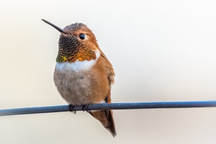 This morning I watched aghast as Mr. Rufous hit the window and fell to the ground. Rushing out to give him sugar water, I was so relieved to see him recover his wits and fly towards his cottonwood bower on his own. A very close call. Rufous, an iridescent coppery jewel arrived here on June 22 and his mate – just as beautiful in her less dramatic emerald and rust attire, came with him. My other resident hummingbirds (black chin, and broadtail) all seemed to be cooperating as they visited my two feeders. I wondered how Rufous and his wife would fit in so I have been keeping a sharp eye on hummingbird cooperation dynamics. Five weeks have gone by since their arrival, and this couple is staying to raise a family. It is true that this pugnacious little hummingbird can throw a wrench into cooperation but I have been pleasantly surprised to see this male and female sipping nectar with other birds sitting on neighboring perches. Could it be that the broadtail and black chin social dynamic has rubbed off on Mr. and Mrs. Rufous? I have no way of knowing but it does seem that they are more willing to compromise than most others I have known. Some days, of course, Mr. Rufous hovers above the feeders and making sudden aggressive dives scaring the others away with his high pitched squeaks and buzzing - but only for a few moments. Usually he lets the others return to share quite companionably. Mrs. Rufous seems very cooperative and she has taken to visiting the nastursiums, scarlet runner beans, fiery salvia, deep rose and scarlet penstemon and the pot that holds my bee, butterfly, and hummingbird friendly wildflower mixture that Iren gave me last spring. Apparently, the territories that the male and female rufous hummingbirds “defend” are somewhat different. Males hover over the primary food source(s) while the females extend their ranges further afield choosing less dense wildflower meadows. But this year, except for my little pot garden there are few wildflowers beyond the fence where I do not water, so choices, at least here, are limited. And Mrs. Rufous does not hog these flowers. Rufous hummingbirds are small with a short tail with mighty flight skills that allow them to travel 2000 miles from Mexico to as far north as Alaska for breeding in the western states. This migration can take place from as early as May to August in New Mexico, and some stop along the way to raise their families. They follow the wildflower season throughout the rocky mountain area. During their long migrations, they make a clockwise circuit of western North America each year moving up the Pacific Coast in late winter and spring, reaching Washington and British Columbia by May. As early as July they may start south again, traveling down the chain of the Rocky Mountains. The adult male has a slender bill, white breast, a rusty face, flanks and tail with a startlingly beautiful orange-red throat patch or gorget. Some males have some green on back and/or crown. The female has green, white, some iridescent orange and a dark tail with white tips. The female is slightly larger than the male and has longer wings. As many of us know they feed on nectar from flowers using a long extendable tongue or capture insects on the wing. These birds require frequent feeding while active during the day and go into a state of torpor at night to conserve energy. Because of their small size, they are vulnerable to insect-eating birds and animals. Most breeding habitats are open areas, mountainsides and forest edges in western North America and the Pacific Northwest. The female builds a nest in a tree or shrub and raises her brood of two chicks alone. The offspring are ready for flight in about three weeks. Surveys show continuing declines in rufous numbers during recent decades. Because they rely on finding the right conditions in so many different habitats at just the right seasons during the year, this hummingbird is especially vulnerable to the effects of climate change. These iridescent "flower birds," were considered gifts from the gods by Indigenous peoples. In Peru and other South American countries, naturalists have cataloged over three hundred species, and it is believed that not all have been discovered yet. The rain forests of South America were probably where hummingbirds first evolved (co-evolved) with flowers. I like to imagine that hummingbirds once sipped the life-giving nectar, leaving behind a pollinated forest before flying away, their burnished colors shimmering in a primal world of sunlight…
1 Comment
cristina
7/27/2018 10:21:11 am
Thank you for sharing your learned observations each week. Just to add to your Chama River Valley rufous data base -- In 2016, for the first time in 22 years, our rufouses arrived in a cooperative frame of mind. (what caused this transformation? Perhaps climate change issues have made them hyper-aware that cooperation around resource management means survival?) Also, this year we have 2 pairs, instead of the normal one pair.
Reply
Your comment will be posted after it is approved.
Leave a Reply. |
Submit your ideas for local feature articles
Profiles Gardening Recipes Observations Birding Essays Hiking AuthorsYou! Archives
October 2025
Categories
All
|
 RSS Feed
RSS Feed